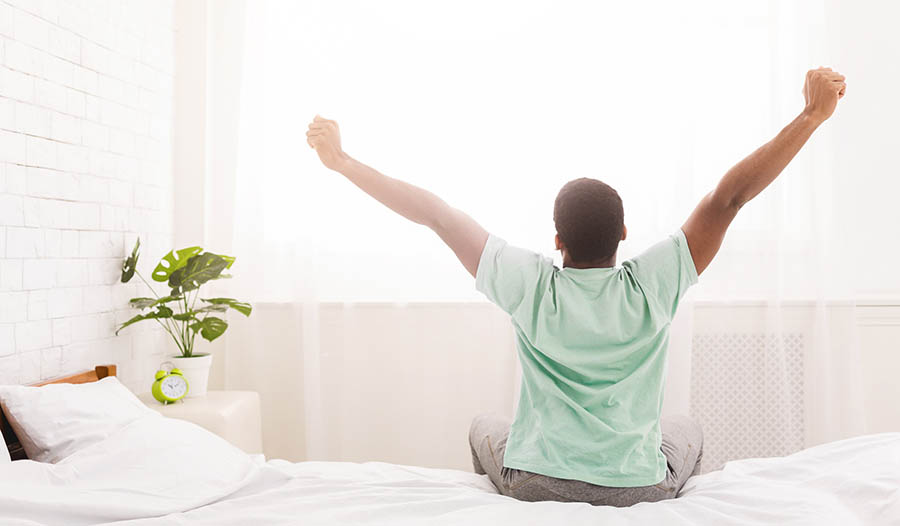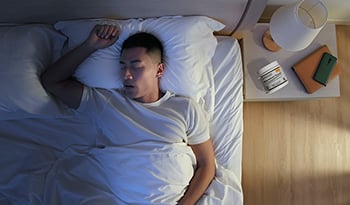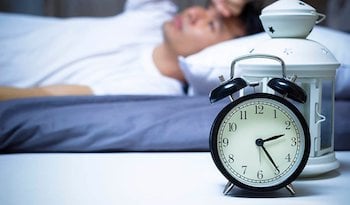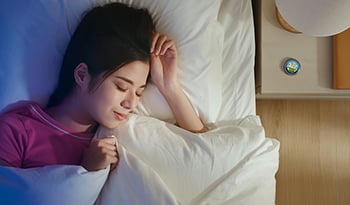Melatonin – Not Just for Sleep
DISCLAIMER:This blog does not intend to provide diagnosis...
- In this article:
- Here are some lesser- known benefits of melatonin.
- Melatonin May Help Reduce Jet lag
- Melatonin and REM Behavior Disorder – Restless Nights
- Melatonin and Sundowning
- Melatonin May Help with Sleep Problems from Antidepressants
- Melatonin, Retinal Health, and Good Vision
- Melatonin and Cognitive Function
- Melatonin and Autism
- Melatonin Interactions with Medications
- Quality of Melatonin

The neurohormone Melatonin is best known as a gentle, natural sleep aid. Unlike many prescription sleeping pills, melatonin is not addicting and does not cause withdrawal symptoms. It comes in two forms, short-acting and long-acting. Short-acting melatonin helps us fall asleep; long-acting helps us stay asleep. Depending on your pattern of insomnia, you may choose short-acting, long-acting, or a combination of both. Melatonin is also a strong antioxidant (Ramis et al. 2015). In addition, it helps regulate energy metabolism (Cipolla-Neto et al. 2014) and immune function (Calvo et al. 2013).
Melatonin is produced by the pineal gland. The suprachiasmatic nuclei in the hypothalamus, a small light-sensitive structure, regulates the melatonin. Daylight inhibits the suprachiasmatic nuclei and the production of melatonin. Darkness allows the suprachiasmatic nucleus to signal the pineal gland to increase melatonin release, regulating our circadian rhythms, including the time we are likely to fall asleep at night and the time we are likely to wake up in the morning. Every year, as the length of daylight changes, the pineal gland changes its release of melatonin, adjusting our bio-rhythms to match the seasonal changes. One cause of insomnia is that some people have more difficulty adjusting their sleep-wake cycle to seasonal changes in ambient light. Consequently, they develop insomnia, trouble sleeping. Others may have a decrease in melatonin production, for example, with aging. We may disrupt our circadian rhythms by crossing too many time zones, staying up too late at night, working night shifts, sleeping too late in the morning, or taking daytime naps (Brown and Gerbarg 2009).
For mild insomnia, 1 or 2 mg of melatonin may be all that is needed. For moderate insomnia, 3 to 6 mg is an average for most adults. Severe insomnia may require up to 9 or 10 mg of melatonin. Melatonin can be used safely in combination with sleep medications (eg. sedative-hypnotics, benzodiazepines), antidepressants, and antipsychotics. For better sleep, whether using melatonin, herbs, or prescription medications, sleep hygiene is essential. Sleep hygiene includes setting a regular bedtime, avoiding stimulating activities during the hour before sleep (distressing TV shows, video games, keyboarding), establishing a bedtime routine, getting up the same time every morning, avoiding daytime naps and not taking stimulating foods (chocolate) or drinks (caffeinated coffee or tea) in the late afternoon or evening.
Here are some lesser- known benefits of melatonin.
Melatonin May Help Reduce Jet lag
Many people have difficulty adjusting their sleep-wake cycle when traveling across two or more time zones. Falling asleep at 6 pm because your body clock feels like it’s midnight or sleeping until noon because your body feels like it is 6 am can spoil the first few days of a European vacation. And if you are traveling for business, jet lag can reduce your performance. If you are prone to jetlag, you could benefit from a combination of 3 to 6 mg melatonin starting the first night you arrive at your destination and 150 to 300 mg of Rhodiola Rosea at the time you need to awaken in the mornings.
Melatonin and REM Behavior Disorder – Restless Nights
REM Behavior Disorder (RBD) usually develops after age 70, though it can occur earlier or in people who have had a brain injury. It is characterized by thrashing, kicking, and even punching during sleep. Sometimes, as the brain ages, the neuronal circuits that are supposed to prevent us from physically acting out our dreams become impaired. When the inhibition of movement is lost, the movements can break through during sleep. Needless to say, this takes a toll on the bed partner and can become dangerous. For example, if an 80-year-old man inadvertently pushes his 78-year-old wife off the bed, she could suffer a concussion or a broken bone. Unfortunately, the diagnosis of RBD is often missed and the husband is condemned to sleeping alone on the sofa. The diagnosis can be confirmed by a sleep study. RBD is usually treated with the benzodiazepine, clonazepam, but this class of drugs is problematic, particularly in the elderly because it can increase the risks of falling, mental confusion, disorientation, and habituation or addiction. Compared to clonazepam, melatonin has fewer adverse effects and can be quite beneficial for the treatment of RBD (McGrane et al. 2015). In many cases, melatonin is effective for controlling the symptoms of RBD but may require gradually increasing the dose up to 10 mg at bedtime. It is best to take melatonin about one to two hours before your target sleep time.
Melatonin and Sundowning
‘Sundowning’ is a term used to describe what can happen to elderly individuals when the sun goes down, especially when they are staying in an unfamiliar environment, such as a hospital or elder care facility. When the lights are low, it becomes more difficult for the elderly to orient themselves with visual cues. As they become disoriented and confused, they may wander about and get lost or come to harm. Commonly used sleep medications, such as Ambien or benzodiazepines, can exacerbate the confusion or cause imbalance, falling, daytime somnolence, habituation, or other problems. Starting with a low dose of melatonin, such as 1 mg, and increasing gradually until the ‘sundowning’ stops, but not going above 10 mg at night, is safer and often effective.
Melatonin May Help with Sleep Problems from Antidepressants
Some people develop difficulty sleeping when they are given certain medications, for example, antidepressants of the serotonin reuptake inhibitor (SRI) type. Melatonin may counteract this side effect of prescription antidepressants, thereby restoring sleep.
Melatonin, Retinal Health, and Good Vision
Preliminary studies suggest that melatonin may improve retinal health and prevent or delay retinal deterioration (Crook et al 2017). Retinal problems, particularly macular degeneration commonly occur as we age. Excess exposure to sunlight sets off bursts of free radicals that can cause cumulative damage to the delicate cells of the macula, the central area of the retina from which the optic nerve emerges. Wearing UV protective glasses whenever we are outside on a sunny day is the best protection. Unfortunately, many of us don’t learn about this problem until we are older, after the damage has been done. Further research is needed to assess the degree to which melatonin may prevent, delay, or repair macular degeneration and other retinal problems.
Melatonin and Cognitive Function
Melatonin protects brain cells, neurons, from free radical damage. This is believed to be a key mechanism by which melatonin can improve cognitive function and possibly reduces cognitive decline. The brain burns energy at a very high rate. Whenever cells burn energy, the free radicals released as byproducts damage cellular components, including membranes, mitochondria, and DNA. Fortunately, our cells have the ability to fend off free radicals and to repair the damage they cause. However, aging, chronic illness, and excess stress can impair the ability of cells to keep up with the rate of free radical damage. The result is cumulative damage that impairs memory and cognitive functions. Supplementing our body’s defense systems with antioxidants can help maintain optimal brain functions.
Tardive dyskinesia is a serious movement disorder that can occur as a side effect of antipsychotics and other medications (including serotonin reuptake inhibitors). Tardive dyskinesia (TD) usually begins with abnormal movements of the mouth or tongue. It can also begin with jaw clenching. Melatonin has been found to reduce and, in some cases, prevent the development of TD in patients exposed to antipsychotic or antidepressant medications (Shamir et al. 2001). These benefits are attributed in part to the antioxidant effects of melatonin, which are believed to help protect and repair neurons that have been damaged by medications. The American Academy of Neurology guidelines found insufficient evidence to determine the benefits of melatonin for tardive dyskinesia (Bhidayasiri et al. 2013). Nevertheless, considering the low risks of a trial of melatonin, and the potential benefits, it is worth trying in doses up to 10 mg melatonin per day in patients with TD.
Melatonin and Autism
Children with autism spectrum disorders often have sleep disorders as one component of their physiological dysregulation, which includes disturbances in melatonin secretion (Rossignol and Frye 2014). Studies show that melatonin is safe and effective in improving sleep for children on the spectrum (Tordjman et al. 2015).
Melatonin Interactions with Medications
Melatonin does not have clinically significant interactions with commonly used medications. Furthermore, it and does not adversely affect cognition, memory, or postural stability (Lemoine and Zisapel 2012).
Quality of Melatonin
Obtaining the best quality melatonin is important for achieving good results. Consult reliable sources on the quality of supplement brands. Here are a few:
- National Institutes of Health Information on Dietary Supplements
- ConsumerLab
- NSF International
- Supplementwatch
References:
- Bhidayasiri R, Fahn S, Weiner WJ, et al. Evidence-based guideline: treatment of tardive syndromes: report of the Guideline Development Subcommittee of the American Academy of Neurology. Neurology 81(5):463–469, 2013.
- Brown RP, Gerbarg PL, Muskin PR. How to Use Herbs, Nutrients, and Yoga in Mental Health Care. W.W. Norton & Company, New York. 2009.
- Calvo JR, González-Yanes C, Maldonado MD: The role of melatonin in the cells of the innate immunity: a review. J Pineal Res 55(2):103–120, 2013.
- Cipolla-Neto J, Amaral FG, Afeche SC, et al. Melatonin, energy metabolism, and obesity: a review. J Pineal Res 56(4):371–381, 2014.
- Crooke A, Heute-Toral F, Colligris B, Pintor J. The role and therapeutic potential of melatonin in age-related ocular diseases. J Pineal Res. Sep;63(2), 2017.
- Gerbarg PL, Brown RP and Muskin PR. Editors. Complementary and Integrative Treatments in Psychiatric Practice. Washington D.C., American Psychiatric Association Publishing, 2017.
- Lemoine P, Zisapel N: Prolonged-release formulation of melatonin (Circadin) for the treatment of insomnia. Expert Opin Pharmacother 13(6):895–905, 2012.
- McGrane IR, Leung JG, St Louis EK, et al: Melatonin therapy for REM sleep behavior disorder: a critical review of evidence. Sleep Med 16(1):19–26, 2015.
- Modabbernia A. Chapter 19 Melatonin and Melatonin Analogs for Psychiatric Disorders. In Patricia L Gerbarg, Richard P Brown and Phillip R Muskin PR Editors. Complementary and Integrative Treatments in Psychiatric Practice. Washington D.C., American Psychiatric Association Publishing, 2017.
- Ramis MR, Esteban S, Miralles A, et al. Protective effects of melatonin and mitochondria-targeted antioxidants against oxidative stress: a review. Curr Med Chem 22(22):2690–2711, 2015.
- Tordjman S, Davlantis KS, Georgieff N, et al. Autism as a disorder of biological and behavioral rhythms: toward new therapeutic perspectives. Front Pediatr 3:1, 2015.

 By Dr. Patricia Gerbarg, M.D. and Dr. Richard P. Brown, M.D.
By Dr. Patricia Gerbarg, M.D. and Dr. Richard P. Brown, M.D.


